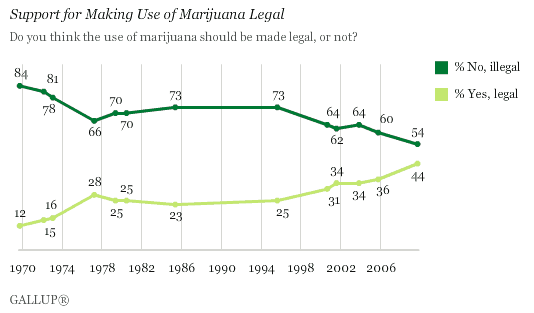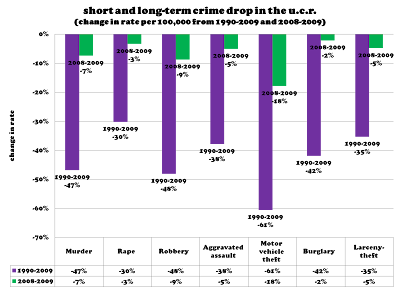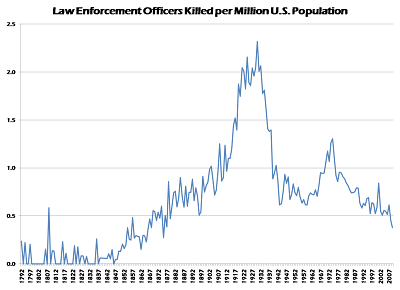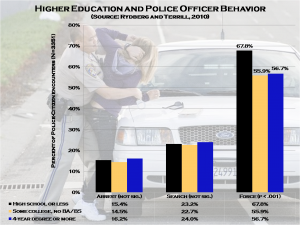In a few weeks, California voters will consider Proposition 19 — The Regulate, Control and Tax Cannabis Act of 2010. This measure (1) legalizes various marijuana-related activities, (2) allows local governments to regulate these activities, (3) permits local governments to impose and collect marijuana-related fees and taxes, and (4) authorizes various criminal and civil penalties. As the national Gallup data indicate below, support for marijuana legalization has risen dramatically over the past quarter century, to the point where such ballot referenda now have a strong chance of passage in states like California.
 I’ve gotten a few calls on the subject and wish I knew more about it. At this point, I defer to my California colleagues because I simply do not feel sufficiently informed or qualified to render an opinion as either an expert or a private citizen on this issue. But I do know this: should Proposition 19 pass, it would likely portend a Very Big Change in past practices and policies with respect to marijuana. Some excellent researchers at the RAND Drug Policy Research Center (Beau Kilmer, Jonathan P. Caulkins, Rosalie Liccardo Pacula, Robert J. MacCoun, Peter H. Reuter) have made heroic efforts to model the likely effects of such a Very Big Change, based on estimates of current and future consumption, likely price changes, taxes levied and evaded, and nonprice effects (such as a change in stigma), but they acknowledge that we are in uncharted waters. Their best guess?
I’ve gotten a few calls on the subject and wish I knew more about it. At this point, I defer to my California colleagues because I simply do not feel sufficiently informed or qualified to render an opinion as either an expert or a private citizen on this issue. But I do know this: should Proposition 19 pass, it would likely portend a Very Big Change in past practices and policies with respect to marijuana. Some excellent researchers at the RAND Drug Policy Research Center (Beau Kilmer, Jonathan P. Caulkins, Rosalie Liccardo Pacula, Robert J. MacCoun, Peter H. Reuter) have made heroic efforts to model the likely effects of such a Very Big Change, based on estimates of current and future consumption, likely price changes, taxes levied and evaded, and nonprice effects (such as a change in stigma), but they acknowledge that we are in uncharted waters. Their best guess?
(1) the pretax retail price of marijuana will substantially decline, likely by more than 80 percent. The price the consumers face will depend heavily on taxes, the structure of the regulatory regime, and how taxes and regulations are enforced;
(2) consumption will increase, but it is unclear how much, because we know neither the shape of the demand curve nor the level of tax evasion (which reduces revenues and prices that consumers face);
(3) tax revenues could be dramatically lower or higher than the $1.4 billion estimate provided by the California Board of Equalization (BOE); for example, uncertainty about the federal response to California legalization can swing estimates in either direction;
(4) previous studies find that the annual costs of enforcing marijuana laws in California range from around $200 million to nearly $1.9 billion; our estimates show that the costs are probably less than $300 million; and
(5) there is considerable uncertainty about the impact of legalizing marijuana in California on public budgets and consumption, with even minor changes in assumptions leading to major differences in outcomes.
So, marijuana will become significantly cheaper in California, but we cannot tell for certain whether the increase in consumption will be correspondingly large (say, to the peak marijuana levels of the late-1970s). We also can’t say for sure how much will be collected or evaded in taxes, saved or spent on treatment and law enforcement, or how neighboring states and the federal government will respond. The RAND report is helpful in showing both the kinds of factors to be considered before casting one’s ballot and the limits of our current knowledge base.
On balance, will we be better off or worse off in a post-Prop. 19 world? At this point, responsible experts, including the RAND team, are pointing to an unusually large gap between the change voters must consider and our knowledge about its likely impact. Call me gutless, but under such conditions my personal preference would be for a gradual phase-in and limited pilot period before attempting to flip such a Very Big Switch in a state of 39 million people.










